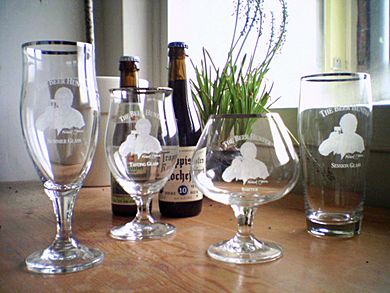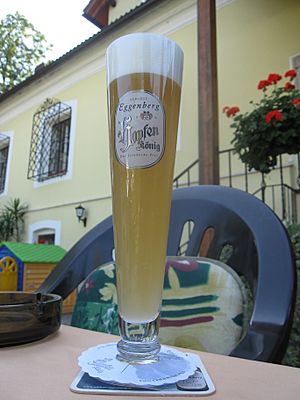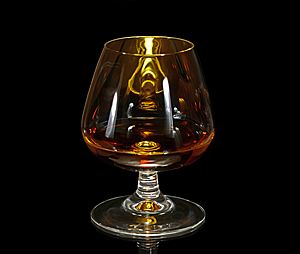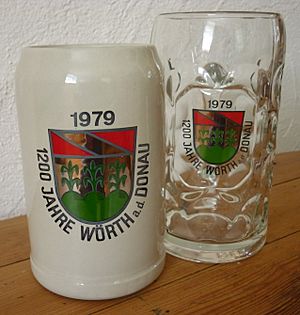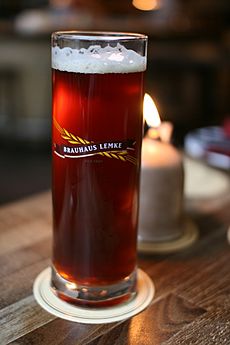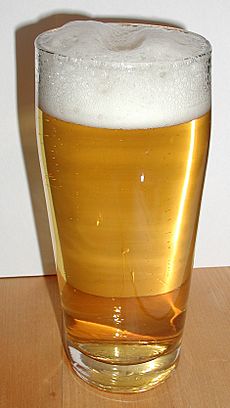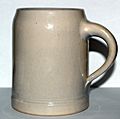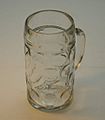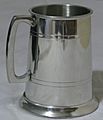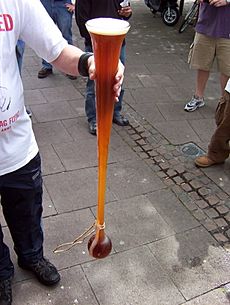Beer glassware facts for kids
Beer glasses are special cups made of glass. They are designed or often used for serving and drinking beer. These glasses come in many shapes and sizes. This depends on traditions from different countries or regions. Some designs help prevent breakage when washing or stacking. Breweries also use special glasses to promote their brands.
Sometimes, glasses are made for art or fun, like for drinking games. Most importantly, the shape of a glass can make a specific type of beer look, smell, and taste better. For example, some glasses help keep the foamy top (called the "head") of the beer just right. While many beer cups are glass, some are made from other materials like pottery, metal (pewter), or wood.
Contents
Different Types of Beer Glasses
Pilsner Glasses
A pilsner glass is often used for light beers, like pale lager or pilsner. These glasses are usually smaller than a pint glass. They typically hold about 200 ml, 250 ml, 300 ml, 330 ml, or 400 ml. In Europe, 500 ml glasses are also common.
Pilsner glasses are tall, thin, and get narrower towards the bottom. Their slender shape lets you see the beer's color and bubbles clearly. The wider top helps keep the beer's foamy head. Sometimes, people confuse pilsner glasses with weizen glasses because they look a bit alike. However, true pilsner glasses have a straight taper without any curves.
Pint Glasses
The size of a "pint" changes depending on the country. So, a pint glass will match the usual serving size in that place. In the UK, a pint of beer is legally 568 ml (about 1.2 US pints). Half-pint glasses (284 ml) are smaller versions of pint glasses. Quarter-pint glasses (140 ml) are also used, especially in Australia, where they are called a "pony."
In the US, a pint is 473 ml, but the size can vary a little. Glasses that hold 500 ml are often called pints in America.
Common shapes for pint glasses include:
- Conical glasses: These are shaped like an upside-down cone. They are about 15 cm tall and get narrower by about 2.5 cm in width from top to bottom.
- Nonic glasses: This is a type of conical glass that bulges out a few centimeters from the top. This bulge helps you grip the glass better. It also stops glasses from sticking together when stacked and makes the rim stronger, so it doesn't chip easily. The name "nonic" comes from "no nick."
- Jug glasses (or "dimple mugs"): These look more like a large mug with a handle. They have a pattern of thick glass bumps on the outside. These bumps help prevent the glass from slipping, especially when wet. This design also makes the glass very strong. Dimpled glasses are less common now but are seen as more traditional. They are also called "Handles" because of their handle. Older people or those with hand movement difficulties often find them easier to hold.
Special Glasses for Experts
Some beer enthusiasts buy special, unique glasses to enjoy their beer even more. Michael "Beer Hunter" Jackson, a famous writer, even had his own line of these glasses.
Snifters
Snifters are usually used for brandy. However, they are also great for beers with strong smells, like Double/Imperial IPAs, Belgian ales, and barley wines. Their shape helps to trap the beer's smells. You can also swirl the beer in the glass to release even more aroma.
Taster Glasses
These small glasses hold 1/3 of a pint or less. They are used for a few reasons:
- To try a beer at a pub or cafe before buying a full glass.
- To share a bottle of a rare or strong beer with friends.
- To sample many different beers without drinking too much. For example, a brewpub might offer a sampler of three beers in small measures. Beer festivals often provide small glasses for visitors to try many types.
Plastic Glasses
Plastic beer cups usually look like the glass versions common in that area. They are mainly used when glass might break easily, like at outdoor events or concerts.
German, Austrian, and Swiss Beer Glasses
Weizen Glasses
A weizen glass is used for wheat beer. It started in Germany. The glass is narrow at the bottom and gets a bit wider at the top. This wider top helps release the beer's smell and makes room for the often thick, fluffy foam that wheat beers produce. Weizen glasses are usually taller than pint glasses. They typically hold 500 ml, with extra space for the foam. In some countries, like Belgium, they might be 250 ml or 330 ml.
Wheat beers tend to foam a lot, especially if poured quickly. In pubs, if you pour your own beer, the glass might be given to you wet. This helps prevent too much foam.
Beer Steins
A "stein" is an English word for a traditional German beer mug. These mugs are often made of stoneware. They can be simple and strong, or very fancy with traditional designs. Some are sold as souvenirs or collectibles. Steins can be made of glazed pottery, porcelain, pewter, or even silver or crystal. They might have an open top or a hinged pewter lid with a thumb-lever.
German steins often have a line on the side showing their capacity, like 0.4 liters, 0.5 liters (half a liter), or a full liter. Like decorative tankards, steins often have designs that remind people of German or Bavarian culture. Some people believe the lid, which keeps flies out of the beer today, was originally meant to protect against diseases long ago.
Maßkrug
The Maß (pronounced "mass") is a 1-liter amount of beer. It is most common in Bavaria and Austria. It is served in a Maßkrug (plural: Maßkrüge), which is sometimes just called a Maß. This unit of volume is usually only for beer sold to drink right away. A Maßkrug can be a glass or stoneware mug.
There's a sport called Maßkrugstemmen where people hold a full, 2.4 kg Maß glass with their arm stretched out. The world record is 45 minutes and 2 seconds!
Stangen Glasses
The Stange (German for "stick" or "rod") is a tall, narrow, and cylindrical glass. It is traditionally used for Kölsch beer. A Becher glass, used for Altbier, is similar but a bit shorter and wider. Stangen usually hold between 100 ml and 200 ml. However, larger ones are sometimes used now to make serving easier. Stangen are often carried in a special tray with holes, called a Kranz ("wreath").
Willi Becher Glasses
The Willi Becher glass is very common in Germany. It has a unique shape: it's conical (like a cone) at the bottom, then curves inward near the top, making the opening smaller. Willi Becher glasses come in sizes like 200, 250, 300, 400, and 500 ml.
Beer Boots
Drinking cups shaped like boots have been found in ancient sites from the Bronze Age. Modern beer boots (or Bierstiefel) have a history of over a hundred years. A common story says that a general once promised his soldiers he would drink beer from his boot if they won a battle. When they won, he had a glassmaker create a glass boot. This way, he could keep his promise without actually drinking from his leather boot or spoiling the beer. Since then, soldiers have enjoyed celebrating victories with a beer boot.
At gatherings in Germany, Austria, and Switzerland, beer boots are often passed around for a fun drinking challenge. Since the movie Beerfest came out in 2006, beer boots have become more popular in the United States.
Pilstulpe Glasses
The Pilstulpe ("Pilsner Tulip") or Biertulpe ("Beer tulip") is the traditional glass for German pilsner beers. They usually hold around 300 ml, but can be as large as 500 ml. In restaurants, a small piece of paper is often placed around the bottom to catch any drips from spills or condensation.
Belgian and Dutch Beer Glasses
Stronger or bottled beers in Belgium and the Netherlands are often served in special, branded glasses. Besides the many glasses from breweries, some Belgian beer cafes use their own "house" glasses.
Flute Glasses
A glass similar to a champagne flute is preferred for Belgian lambics and fruit beers. Its narrow shape helps keep the beer bubbly. It also provides a strong smell when you drink. Flute glasses show off the lively bubbles, bright color, and soft foam of these unique beers.
Goblets or Chalices
Chalices and goblets are large, stemmed, bowl-shaped glasses. They are good for serving heavy Belgian ales, German bocks, and other strong beers meant for slow sipping. The main difference between a goblet and a chalice is how thick the glass is. Goblets are usually thick, while chalices have thin walls. Some chalices even have a special etching at the bottom to create a stream of bubbles, which helps keep a nice foamy head.
Tulip Glasses
A tulip glass looks a bit like a brandy snifter. The main part of the glass is round, like a snifter. But the top flares out to form a lip. This lip helps keep the foamy head of the beer. Tulip glasses are suggested for Scottish ales, American double/imperial IPAs, barley wines, Belgian ales, and other beers with strong smells. Some pint glasses that widen towards the top are also called tulip glasses, even if they are less curved.
British and Irish Beer Glasses
Tankards
A tankard is a type of drinking cup. It is large and mostly cylindrical, with a single handle. Tankards are usually made of silver, pewter, or glass. But they can also be made from wood, ceramic, or leather. A tankard might have a hinged lid. Tankards with glass bottoms are also common. They are shaped and used similarly to beer steins.
Metal tankards were popular in Britain and Ireland in the 1700s and early 1800s. But glass cups largely replaced them. Now, they are often collector's items or given as engraved gifts. Wooden and leather tankards were popular before the 1600s. However, because they are made of natural materials, very few have survived to today.
Yard of Ale Glasses
A yard of ale, or yard glass, is a very tall glass. It is used for drinking about 2.5 imperial pints (about 1.4 liters) of beer, depending on how wide it is. The glass is about 90 cm (1 yard) long. It has a bulb shape at the bottom and a widening shaft that makes up most of its height.
This glass likely started in England in the 1600s. It was also known as a "Long Glass" or an "Ell Glass." It is sometimes linked to old stagecoach drivers. However, it was mainly used for fun drinking challenges and special toasts.
Drinking a yard glass full of beer is a traditional pub game. The fastest time to drink a yard of ale, according to the Guinness Book of Records, is 5 seconds.
Beer Glass Sizes Around the World
Different countries have different names and sizes for beer glasses. Here's a table showing some common volumes and their names in various countries:
| Volume | France | Belgium | Netherlands | Germany | Austria | Switzerland | Czech Republic | Italy | Spain | UK | Ireland | Australia | Quebec |
|---|---|---|---|---|---|---|---|---|---|---|---|---|---|
| 125 ml | Galopin, Bock | Benjamin | Birrino | Zurito (Basque) | |||||||||
| 200 ml | Flûte, Hollandais | Fluitje, Buisje, Pijpje | Stange (Cologne, for Kölsch) | Galopin (French), Herrgöttli (German) | Birra Piccola | Caña | |||||||
| 250 ml | Demi, Bock | Boerke, Chope, Pintje | Vaasje, Emmertje, Rendsje, Amsterdammertje, Rotterdammertje | Botellín | |||||||||
| 284 ml | Middy, Ten, Half | Middy, Ten, Half, Glass | |||||||||||
| 285 ml | Middy, Pot, Handle, Half | ||||||||||||
| 300 ml | Seidl, Seitel, Seiterl | Jonker | Becher, Stange, Rugeli | ||||||||||
| 330 ml | Gourde, Klepke | Canette | Třetinka | Tercio, Mediana | |||||||||
| 400 ml | Birra Media | ||||||||||||
| 425 ml | Schooner | ||||||||||||
| 500 ml | Distingué, Baron, Mini-chevalier, Chope, Pinte, Sérieux | Demi | Pul | Seidel, Seidla, Halbe (Southern Germany) | Krügel, Krügerl, Halbe | Chope (French), Grosses (German) | Půllitr | Pinta | |||||
| 568 ml | Pint | Pint | Chopine | ||||||||||
| 570 ml | Pint | ||||||||||||
| 775/950 ml | Humpen | Holba | Beer stein | ||||||||||
| 1000 ml | Chevalier, Parfait, Double Pinte, Formidable | Corbeau, Lunette, Litron | Maß | Masse/Litron (French), Mass (German) | Tuplák | Birra grande | Pinte | ||||||
| 1138 ml | Quart | Quart | |||||||||||
| 1140 ml | Jug | ||||||||||||
| 2000 ml | Stiefel, Liesl |
Australian Beer Glass Sizes
Before Australia switched to the metric system, you could buy beer in glasses of 4, 5, 6, 7, 10, 15, or 20 imperial fluid ounces. Each size had a different name in each Australian state. These were later replaced by glasses of 115, 140, 170, 200, 285, 425, and 570 ml. Over time, the differences between states are becoming smaller. Today, most pubs don't have glasses smaller than 200 ml. Common sizes are 200 ml, 285 ml, and 425 ml. Many pubs are also starting to offer 570 ml pints.
|
Names of beer glasses in various Australian cities |
|||||||||
|---|---|---|---|---|---|---|---|---|---|
| Capacity | Sydney | Canberra | Darwin | Brisbane | Adelaide | Hobart | Melbourne | Perth | |
| 115 ml (4 fl oz) | – | – | – | – | - | small beer | foursie | shetland | |
| 140 ml (5 fl oz) | pony | – | – | pony | pony | – | horse/pony | pony | |
| 170 ml (6 fl oz) | – | – | – | – | butcher | six (ounce) | small glass | bobbie/six | |
| 200 ml (7 fl oz) | seven | – | seven | beer | butcher | seven (ounce) | glass | glass | |
| 285 ml (10 fl oz) | middy | middy / half pint | handle | pot | schooner | ten (ounce) | pot | middy / half pint | |
| 350 ml (12 fl oz) | schmiddy | – | – | – | – | – | – | – | |
| 425 ml (15 fl oz) | schooner | schooner | schooner | schooner | pint | fifteen / schooner | schooner | schooner | |
| 570 ml (20 fl oz) | pint | pint | pint | pint | imperial pint | pint | pint | pint | |
| Notes: | References:
|
||||||||


